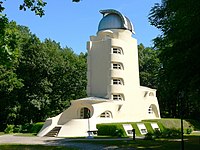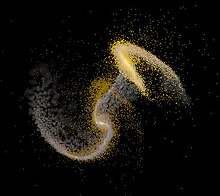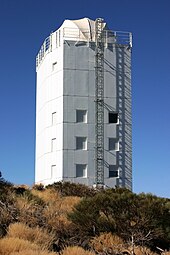Leibniz Institute for Astrophysics Potsdam
| Leibniz Institute for Astrophysics Potsdam | |
|---|---|
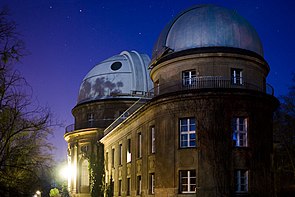 Main building in Babelsberg (Humboldthaus) |
|
| Category: | research Institute |
| Carrier: | none (legally independent foundation under civil law ) |
| Membership: | Leibniz Association |
| Facility location: | Potsdam |
| Type of research: | Basic research |
| Subjects: | Natural sciences |
| Areas of expertise: | Astronomy and astrophysics |
| Basic funding: | Federal government (50%), states (50%) |
| Management: | Matthias Steinmetz |
| Employee: | approx. 175 |
| Homepage: | www.aip.de |
The Leibniz Institute for Astrophysics Potsdam (formerly Astrophysical Institute Potsdam , hence abbreviated AIP ) is a foundation under civil law and a research institution of the Leibniz Association . It is based in Potsdam-Babelsberg , and it also includes the Einstein Tower solar observatory and the Great Refractor on the Telegrafenberg in Potsdam. The institute was founded in 1992 as the successor to the Central Institute for Astrophysics of the Academy of Sciences of the GDR . The history of this Brandenburg research facility goes back to the Berlin observatory founded in 1700 and the Potsdam Astrophysical Observatory in 1874 . Some of the most important astrophysicists belonged to the institute and its predecessors .
The research areas include the main fields of astronomy and astrophysics , from solar and star physics to star and galaxy formation and cosmology . The stellar and cosmic magnetic fields ( magnetohydrodynamics ) and gravitation play an important role as influencing factors in different size scales. In addition, the institute is a partner of the Large Binocular Telescope in Arizona , built robotic telescopes in Tenerife and in the Antarctic , developed astronomical instrumentation for large telescopes such as the VLT of the ESO . In addition to ground-based astronomy, the institute is also involved in space projects of the European Space Agency (e.g. Solar Orbiter ) and works in the field of e-science .
history
Timetable
- 1700 Introduction of the so-called 'Improved Calendar' in the Protestant states of Germany
- May 10, 1700 The calendar patent is issued for the Berlin observatory to be founded
- May 18, 1700 Gottfried Kirch was appointed director of the observatory
- July 11, 1700 Foundation of the Electoral Brandenburg Society of Sciences
- 1711 Construction of the first observatory building
- 1832–1835 Construction of the new Berlin observatory by Karl Friedrich Schinkel
- 1846 discovery of the planet Neptune by Johann Gottfried Galle
- 1865 Wilhelm Julius Foerster was appointed director
- 1874 Foundation of the Astronomical Computing Institute
- 1874 Foundation of the Astrophysical Observatory Potsdam (AOP)
- 1876–1879 Construction of the main building of the astrophysical observatory on the Telegrafenberg in Potsdam
- 1881 first Michelson attempt in Potsdam
- 1886 discovery of the canal rays by Eugen Goldstein
- 1888 proof of Polhöhenschwankung by Karl Friedrich Küstner
- 1888 first photographic radial velocity measurement by Hermann Carl Vogel
- 1896 Johannes Wilsing and Julius Scheiner attempted to detect radio emissions from the sun at the AOP
- 1899 Completion of the Potsdam Great Refractor
- 1904 Karl Hermann Struve is appointed director of the Berlin observatory
- 1909 Karl Schwarzschild is appointed director of the AOP
- 1911–1913 Construction of the observatory in Babelsberg
- 1913 Relocation of the Berlin observatory to Babelsberg
- 1913 Introduction of photoelectric photometry by Paul Guthnick in Babelsberg
- 1915 Completion of the Babelsberg large refractor
- 1921–1924 Construction of the Einstein Tower on Telegrafenberg
- 1924 Completion of the 1.22 m mirror in Babelsberg
- 1931 The Sonneberg observatory is incorporated into the Babelsberg observatory
- January 1, 1947 Takeover of AOP and Babelsberg observatory by the German Academy of Sciences
- 1954 Start of radio observations in Tremsdorf
- 1960 Completion of the 2 m mirror in Tautenburg
- 1969 Foundation of the Central Institute for Astrophysics
- January 1, 1992 Start of activity at the Astrophysical Institute Potsdam (AIP), Karl-Heinz Rädler becomes scientific director
- 1998 Günther Hasinger becomes scientific director of the AIP
- 2001 Klaus G. Strassmeier becomes scientific director of the AIP
- 2004 Matthias Steinmetz becomes scientific director of the AIP
- 2011 The institute is renamed from 'Astrophysical Institute Potsdam' to 'Leibniz Institute for Astrophysics Potsdam (AIP)'.
- 2012 Inauguration of the GREGOR solar telescope on Tenerife
- 2013 Big anniversary celebration "100 years Babelsberg observatory"
Beginnings
Elector Friedrich III. founds the Brandenburgische Societät on July 11, 1700 . Previously, the calendar monopoly had been granted to an observatory that had yet to be founded and Gottfried Kirch was appointed director on May 18, 1700. The observatory was supposed to help finance the academy with the fees for the basic calendar it calculated and distributed, and it actually did so until the beginning of the 19th century. The basic calendar was calculated at the observatory, which has since moved to Babelsberg , until 1991 . In 1711 the first observatory building was erected on Dorotheenstrasse in Berlin, followed by a new building in Lindenstrasse in 1835 .
The discovery of the planet Neptune in 1846 by Johann Gottfried Galle made the Berlin observatory known worldwide. Just as important were the discovery of the canal rays and the proof of the fluctuation of the polar heights of the earth by Karl Friedrich Küstner in 1888. The last two scientific feats occurred during the time of the directorate of Wilhelm Julius Foerster , who at the same time played a decisive role in the establishment of the observatories in Potsdam : on the establishment of the astrophysical observatory on Telegrafenberg in 1874 and on the relocation of the Berlin observatory to Babelsberg, which was completed in 1913.
The foundation of the Astrophysical Observatory Potsdam

Foerster recognized the spectral analysis developed by Gustav Kirchhoff and Robert Wilhelm Bunsen as one of the first and suggested the construction of a solar observatory in 1871 in a memorandum addressed to the Crown Prince, in which he discussed the importance and practical use of solar research . The Telegrafenberg was chosen as the location. On July 1, 1874, the Astrophysical Observatory Potsdam (AOP) was founded. First, solar observations were carried out from a tower. Construction of the main building began in the fall of 1876, and in the fall of 1879 it was completed and its initial instrumentation was completed. The management of the AOP was assigned to a board of directors consisting of Wilhelm Julius Foerster, Gustav Kirchhoff and Arthur Auwers . In 1882, Hermann Carl Vogel was appointed sole director of the observatory, which under his direction turned more to stellar physics. Vogel was the first to succeed in measuring the radial velocities of stars photographically, and thus discovered the spectroscopic binary stars .
In 1899, which was on the Telegrafenberg Great Refractor , the largest so far built refractor with a 80- and 50-centimeter Dual Lens of crystal healing on a completed Repsold Mount in a dome 24 meters in diameter and with a ceremony in the presence of the Emperor Wilhelm II inaugurated. A decade later, Karl Schwarzschild, one of the most important astrophysicists of this century, was appointed director. In a short time he has made fundamental contributions to astrophysics and the emerging general theory of relativity .
The AOP is linked to the development of the theory of relativity in many ways. So led Albert A. Michelson in 1881 in the basement of the main building for the first time that famous Interferometerversuch to detect the motion of the Earth relative to the aether by whose "failure" one of the foundations for the 1905 by Einstein established special theory of relativity is.
The relocation of the Berlin observatory to Babelsberg
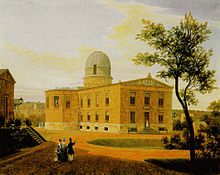
The rapid growth of Berlin at the end of the 19th century had led to the fact that the Berlin observatory , which was originally built outside the city, had been completely rebuilt, making observing activities that met the demands of research almost impossible. As early as the mid-1990s, Wilhelm Julius Foerster, among others, suggested building a new observatory outside Berlin. With the appointment of Hermann von Struves as Foerster 's successor as director in 1904, this project took on concrete form.
After trial observations by Paul Guthnick in the summer of 1906, the decision was finally made in favor of the location on the Babelsberg . The site, which originally belonged to the Babelsberg Park , was made available free of charge. The costs for the new building (1.1 million gold marks ) and for the instrumental equipment (450,000 gold marks) were covered by the sale of the property of the old Schinkel observatory in Berlin, which was later demolished. Construction of the building designed by Georg Thür began in June 1911 under the direction of building officer Hermann Eggert , and the move was completed by early August 1913.
The first new instruments were added in the spring of 1914. In 1915 the installation of the 65 cm refractor, which was the first large astronomical instrument from the Carl Zeiss Jena company, was completed. The completion of the 120 cm mirror telescope took until 1924 as a result of the World War . Struve died in 1920 and could no longer see the completion of his life's work. His successor was Paul Guthnick , who in 1913 introduced photoelectric photometry, the first objective method for determining the brightness of stars in astronomy. With the completion of the 120-centimeter reflector telescope - at the time the second largest telescope in the world - the Babelsberg observatory was the best-equipped observatory in Europe.
The further development of photoelectric photometry , especially in connection with the investigation of the light change of weakly variable stars, as well as spectroscopic work on the 120 cm mirror made the Babelsberg observatory known worldwide. From 1921 to 1938 the astrophysicist Hans Ludendorff was director of the observatory.
At the beginning of 1931 the observatory founded by Cuno Hoffmeister in Sonneberg was attached to the Babelsberg observatory as a branch. The photographic sky surveillance carried out to this day as part of the Sonneberg Field Plan resulted in the second largest astronomical record collection in the world being created in over 60 years. This archive and the associated exploration of variable stars made Sonneberg a household name in astronomy.
During the Nazi era , the Jewish employees were expelled; the decline of astronomy began in Potsdam and Babelsberg. There was hardly any astronomical research during the Second World War .
Development after the Second World War

It was very difficult to start again after the war. The Einstein Tower had suffered severe damage in the air raid on April 14, 1945, and valuable observation instruments in Babelsberg had been dismantled and sent to the Soviet Union as reparations . This is how the 120 cm telescope stands in the Crimean Observatory today .
At the beginning of 1947, the German Academy of Sciences in Berlin took over the Astrophysical Observatory Potsdam and the Babelsberg and Sonneberg observatories . Director Hans Kienle took over the editing of the specialist journal Astronomische Nachrichten , which is still published today at the AIP and is therefore the oldest specialist journal for astronomy still in existence.
In June 1954, the observatory for solar radio astronomy in Tremsdorf (17 km southeast of Potsdam ) began as a branch of the AOP.
In October 1960, the 2 m universal reflector telescope built by Carl Zeiss Jena was inaugurated in the Tautenburger Forest near Jena and thus the Karl Schwarzschild Observatory (today the Thuringian State Observatory Tautenburg ) was founded. This telescope in its Schmidt version is still the largest astronomical wide-angle camera in the world and was the most important observation instrument used by astronomers in the GDR .
In 1969 the Central Institute for Astrophysics was established as part of the GDR Academy of Sciences . Part of the scientific activities concerned cosmic magnetic fields and dynamos, various turbulence phenomena, magnetic and eruptive phenomena on the sun, explosive energy conversions in plasmas, variable stars and star activity. Another part focused on the early phase of cosmic development and the formation of structures in the universe , on large-scale structures up to superclusters and on active galaxies; In this context, methods of digital image processing in particular were developed. In addition, studies on astrometry were carried out with the Schmidt telescope.
The work in the Central Institute for Astrophysics suffered greatly from the effects of the Cold War . Personal contacts with Western colleagues were extremely difficult. With the fall of the Berlin Wall in November 1989, the possibilities for international cooperation improved massively.
Reunification and the establishment of the AIP
The Central Institute for Astrophysics was dissolved on December 31, 1991 due to the provisions of the Unification Treaty on the Academy of Sciences of the GDR. Thanks to the recommendations of the Science Council, the Astrophysical Institute Potsdam was founded on January 1, 1992 on the basis of the Potsdam institute parts and included in the joint federal-state funding. In order to underline its membership of the Leibniz Association , the institute was renamed 'Leibniz Institute for Astrophysics Potsdam (AIP)' on April 15, 2011.
Main research areas
The main research areas of the AIP are “cosmic magnetic fields” and “extragalactic astrophysics”. This includes the following research departments:
- Magnetohydrodynamics and Turbulence (MHD): Magnetic fields and turbulence in stars, accretion disks and galaxies; Computer simulations of dynamos, magnetic instabilities and magnetoconvection
- Solar Physics: observation of sunspots and the solar magnetic field spectrometer polarimetry ; Helioseismology and hydrodynamic calculation models; Study of coronal plasma processes using radio astronomy, among other things; Operation of the Observatory for Solar Radio Astronomy ( OSRA ) in Tremsdorf , with four radio antennas in different frequency ranges from 40 MHz to 800 MHz
- Star physics and star activity: simulations of convection in star atmospheres, determination of stellar surface parameters and chemical abundances, winds and dust covers of red giants, Doppler tomography of star surface structures, development of robotic telescopes and simulations of magnetic flux tubes
- Milky Way and the local environment: exploring our Milky Way, understanding galaxy formation and evolution, star populations
- Galaxies and quasars : mother galaxies and their surroundings, development of quasars and active galactic nuclei, structure and history of the Milky Way, numerical computer simulations of the formation and development of galaxies
- Cosmology : physics of the earlier universe, dark energy and dark matter, simulation calculations of the formation of large-scale structures
Technical projects
Virtual observatory
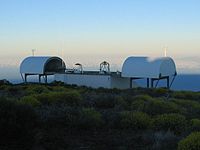
The German Astrophysical Virtual Observatory (GAVO) is an e-science project that creates a virtual observation platform to support modern astrophysical research in Germany. It is the German contribution to international activities to set up a general virtual observatory . GAVO enables standardized access to German and international data archives.
GREGOR
GREGOR is a 1.5 meter telescope for solar research at the Teide Observatory on Tenerife . It is a new type of solar telescope that replaces the previous 45-centimeter Gregory-Coudé telescope. GREGOR is equipped with adaptive optics and will achieve a resolution of 70 kilometers on the solar surface. Exploring these small structures is important to understand the basic processes of the interaction of magnetic fields with the plasma turbulence on the sun . The development of the Gregor telescope is led by the Kiepenheuer Institute for Solar Physics with the participation of several institutes.
The AGWs of the Large Binocular Telescope
The AIP is a partner in the LBT Consortium (LBTC) and contributes financially and in kind to the construction of the Large Binocular Telescope . This includes the development and construction of the optics as well as the mechanical and electronic components as well as the development of the software for the acquisition, tracking and wavefront measuring units (AGWs). The AGW units are an integral part of the telescope and essential for adaptive optics . Functionally, they consist of both an off-axis and an on-axis part.
The Multi Unit Spectroscopic Explorer
The Multi Unit Spectroscopic Explorer (MUSE) is a second-generation instrument for the VLT of the ESO . MUSE is optimized for the observation of the predecessors of normal galaxies up to very high redshifts. It will also provide detailed studies of neighboring normal, interacting, and starburst galaxies .
Potsdam-Echelle-Polarimetric & Spectroscopic Instrument (PEPSI)
PEPSI is a high resolution spectrograph for the LBT . It will enable the simultaneous observation of circular and linearly polarized light with high spectral and temporal resolution. The spectrograph is located in a temperature and pressure stabilized room inside the telescopic column. The light is guided from the telescope to the spectrograph using optical fibers .
STELLA
STELLA is a robotic observatory that consists of two 1.2 m telescopes. It is a long-term project to observe indicators of stellar activity on sun-like stars. Operation takes place automatically, the telescopes automatically decide on the correct observation strategy.
Solar Radio Astronomy Observatory (OSRA)
Radio emissions from the sun's corona are recorded with four different radio antennas in the frequency bands 40–100 MHz, 100–170 MHz, 200–400 MHz and 400–800 MHz . The antennas of the OSRA robotic observatory follow the sun fully automatically.
Shares in large international research projects
Large Binocular Telescope
The Large Binocular Telescope (LBT) is a new telescope on Mt. Grahams, Arizona. The LBT consists of 2 huge 8.4 meter telescopes on a common mount. With its 110 square meters mirror surface, the LBT is the largest telescope in the world on a single mount, only surpassed by the combined VLTs and Kecks .
RAVE
The Radial Velocity Experiment will measure the radial velocities and element abundances of a million stars by 2010, mainly in the southern hemisphere. The 6dF multi-object spectrograph at the 1.2-meter UK Schmidt telescope at the Anglo-Australian Observatory is used for this purpose.
Sloan Digital Sky Survey
The Sloan Digital Sky Survey (SDSS) will examine a quarter of the entire sky in detail and determine the position and absolute brightness of more than 100 million celestial objects. It will also estimate the distances of more than a million galaxies and quasars. With the help of this study, astronomers will be able to determine the distribution of large-scale structures in the universe. This can provide clues about the history of the universe's origins.
LOFAR (LOw Frequency ARray)
LOFAR is a European radio interferometer that measures radio waves with many individual antennas at different locations and combines them into a signal. One of these international LOFAR stations is currently being set up by the AIP in Bornim near Potsdam .
Telescopes and telescope participations of the AIP
- Einstein Tower
- Big refractor
- GREGOR
- Large Binocular Telescope
- Meridian circle
- Solar Radio Astronomy Observatory (OSRA)
- RoboTel
- STELLA
- VTT (participation with HIS)
- Zeiss 70 cm reflector telescope
- Zeiss 50 cm reflector telescope
- Zeiss refractor
Web links
- Leibniz Institute for Astrophysics Potsdam
- Large Binocular Telescope (in English)
- the German Astro-Grid E-Science in AIP
literature
- Spieker: The construction work of the Royal Astrophysical Observatory on the Telegraphenberg near Potsdam . In: Zeitschrift für Bauwesen , Volume 29 (1879), Sp 33–38, Plates 5–7. Digitized
- Wolfgang R. Dick, Klaus Fritze (eds.): 300 years of astronomy in Berlin and Potsdam: a collection of essays on the occasion of the founding anniversary of the Berlin observatory . Verlag Harri Deutsch, Thun, Frankfurt am Main 2000, ISBN 3-8171-1622-5 .
- Dieter B. Herrmann: On the prehistory of the Astrophysical Observatory Potsdam (1865 to 1874) . In: Astronomische Nachrichten 296 (1975) pp. 245-259.
Individual evidence
- ^ The establishment of the Astrophysical Observatory Potsdam. Retrieved January 25, 2018 .
- ^ The Michelson experiment in Potsdam
- ↑ a b Zeiss refractor telescope in Babelsberg
- ↑ a b c Observatory for Solar Radio Astronomy - OSRA project website
- ↑ a b c STELLA robotic observatory (in English)
- ↑ GAVO - German Astrophysical Virtual Observatory (GAVO) (in English)
- ↑ Multi Unit Spectroscopic Explorer - MUSE ( Memento of the original from December 20, 2009 in the Internet Archive ) Info: The archive link was inserted automatically and has not yet been checked. Please check the original and archive link according to the instructions and then remove this notice. (in English)
- ↑ Radial Velocity Experiment - RAVE (in English)
- ^ Meridian circle in Babelsberg
- ↑ RoboTel ( Memento of the original from March 31, 2009 in the Internet Archive ) Info: The archive link was inserted automatically and has not yet been checked. Please check the original and archive link according to the instructions and then remove this notice. public robotic telescope
- ↑ Kiepenheuer Institute for Solar Physics (KIS)
- ↑ Zeiss 70 cm reflector telescope ( Memento of the original from May 5, 2008 in the Internet Archive ) Info: The archive link was inserted automatically and has not yet been checked. Please check the original and archive link according to the instructions and then remove this notice. in Babelsberg
- ↑ Zeiss 50 cm reflector telescope in Babelsberg
Coordinates: 52 ° 24 ′ 18 ″ N , 13 ° 6 ′ 15 ″ E



